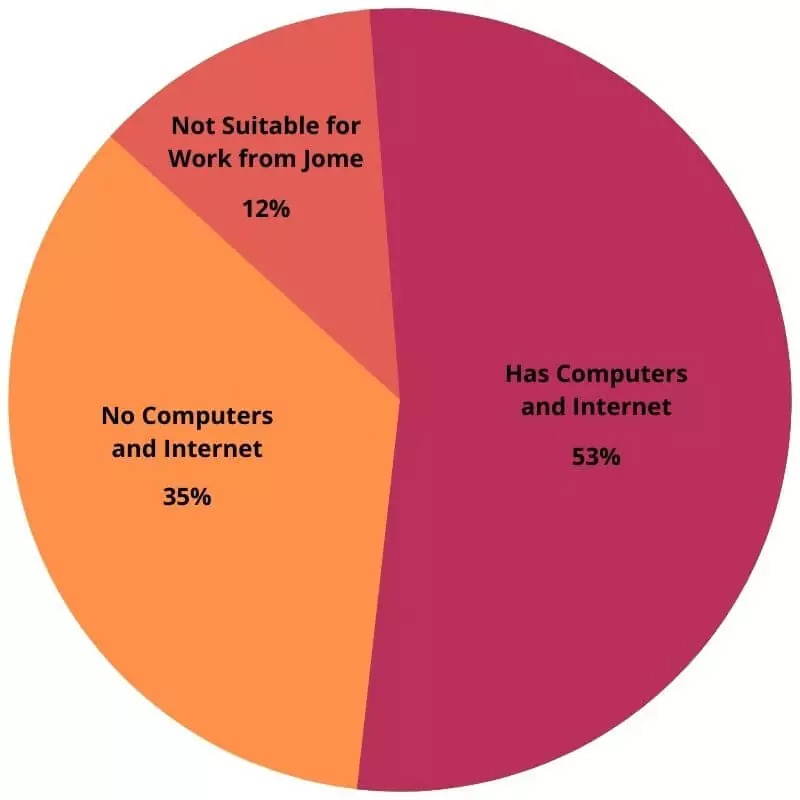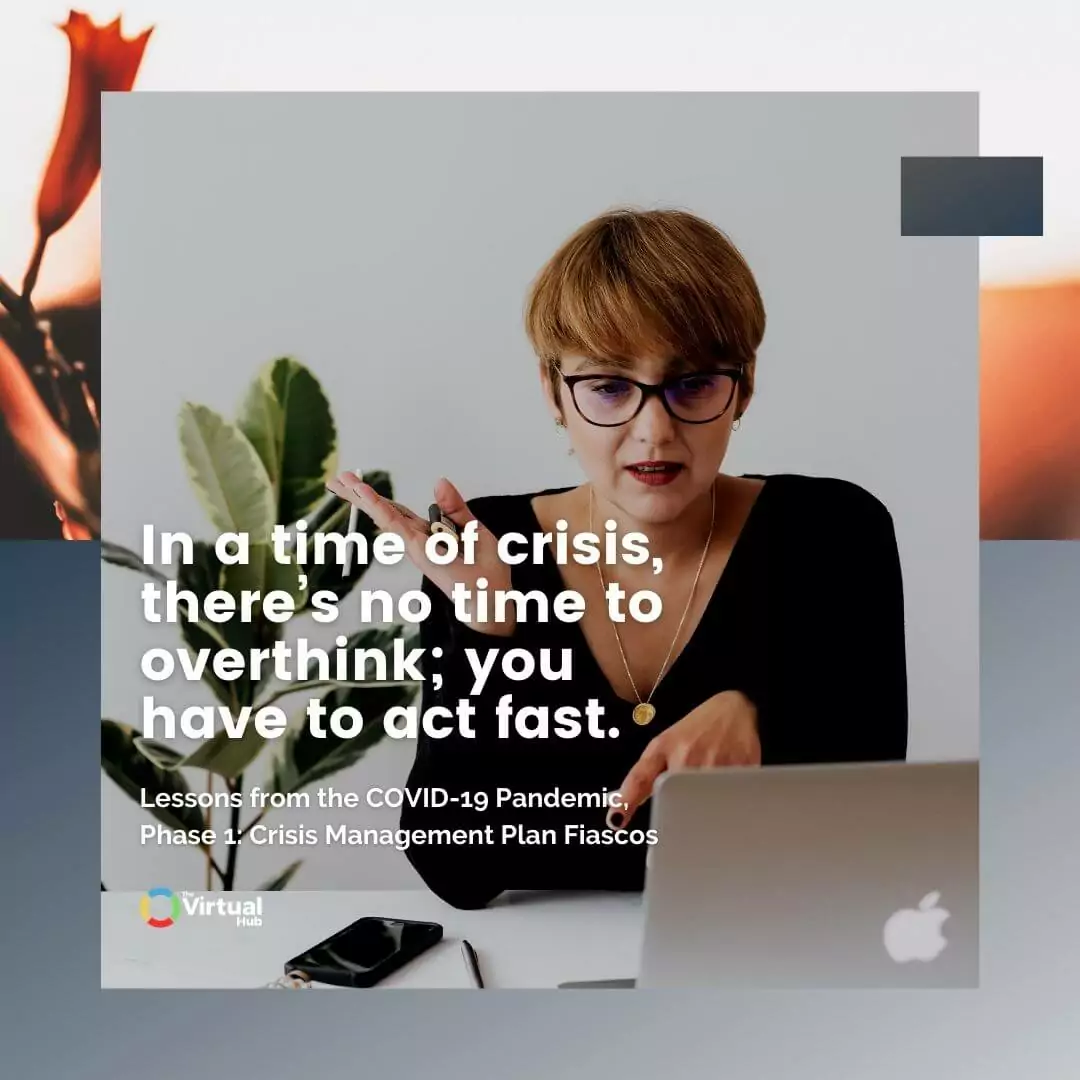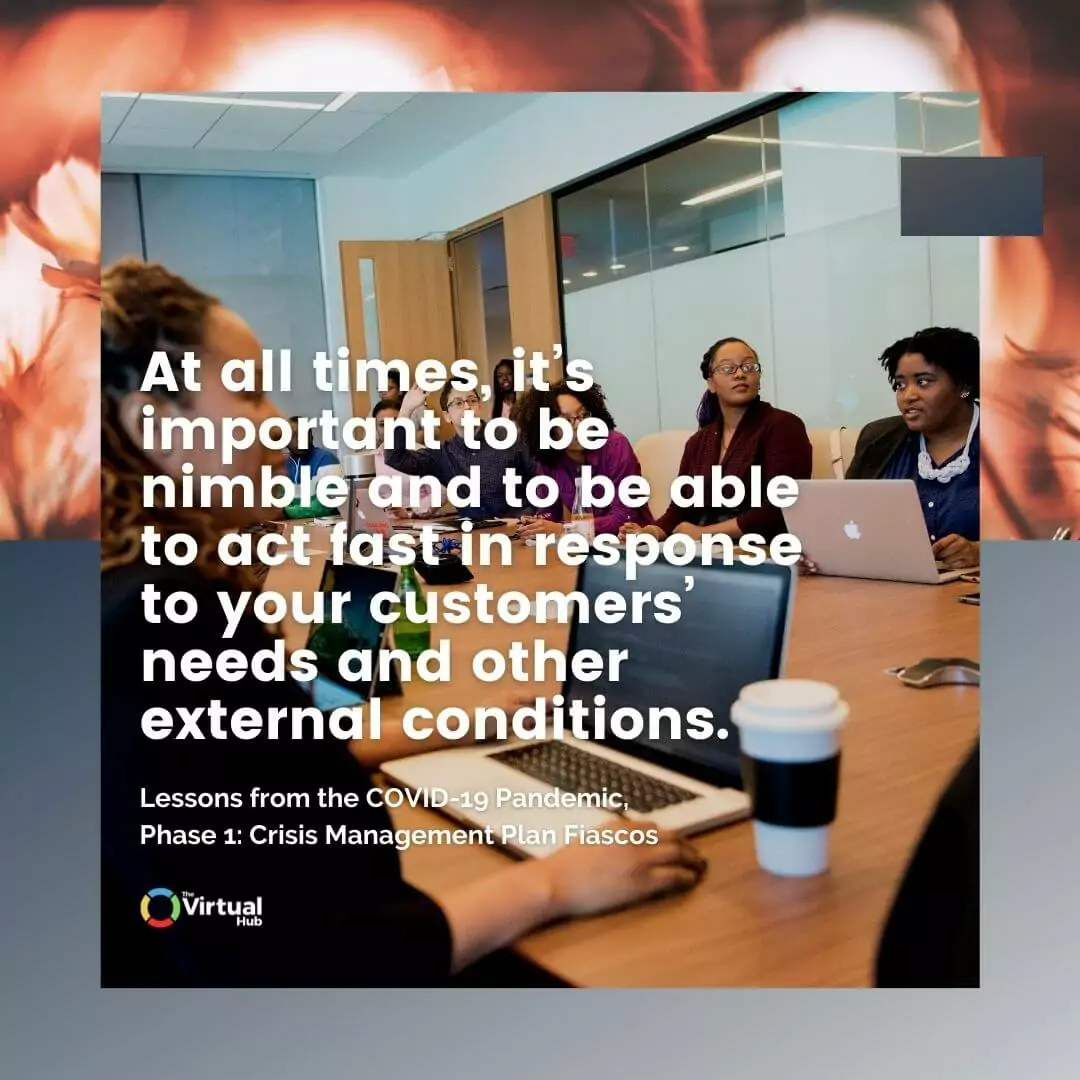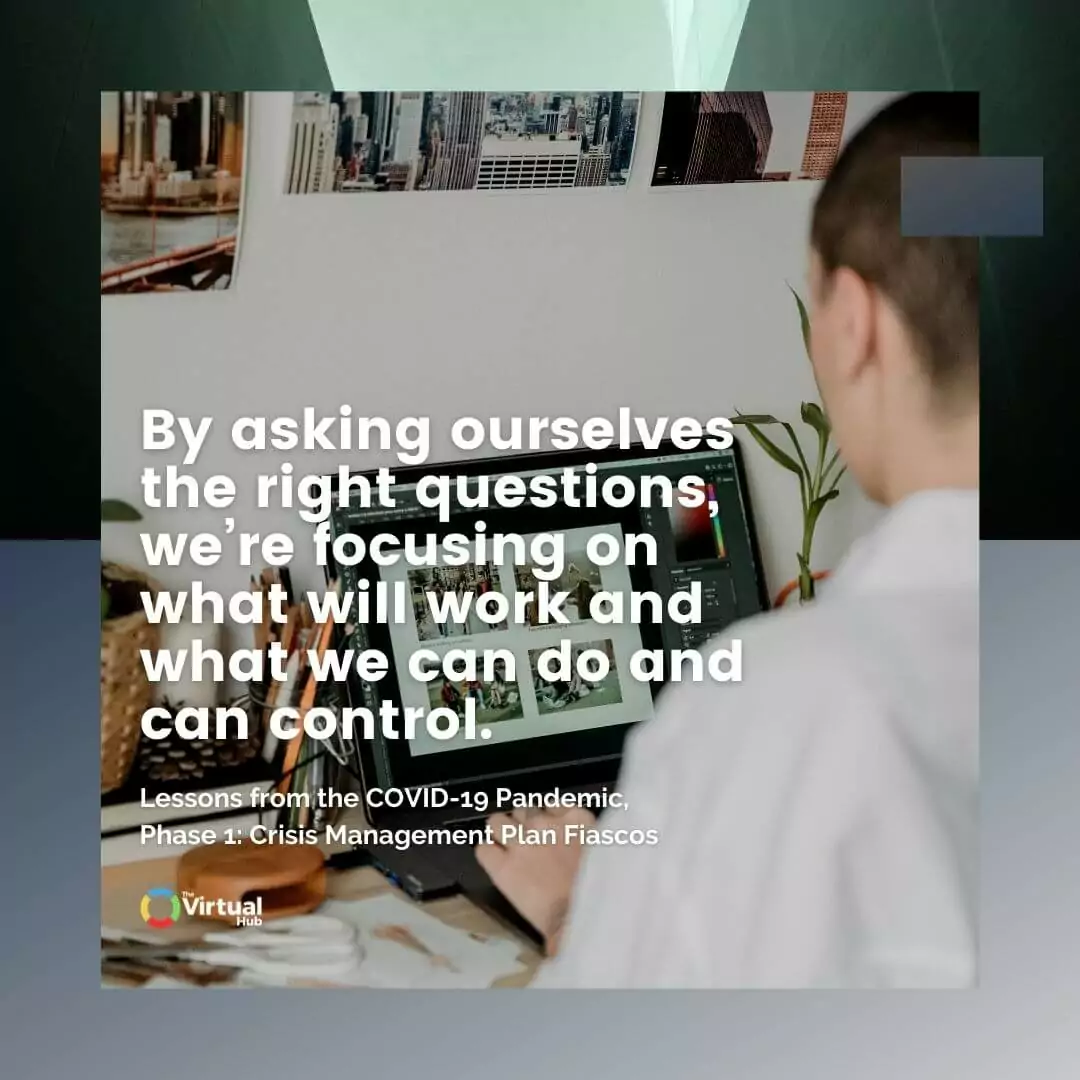Authored by: Barbara Turley, CEO - The Virtual Hub
Overnight, we went from business as usual to total chaos!
Everything changed.
Obviously, I’m referring to the global COVID-19 pandemic that has turned our personal lives and businesses upside down and created a need to flip quickly and decisively into crisis management mode as the situation rapidly unfolds.
We’ve decided to share our experience right here on the blog around what we are thinking, doing and learning through this crazy, unprecedented time.
Our crisis management plan is one we are being forced to create on the fly right now. As the situation is as novel as the virus itself, no one is really in a position to give good business advice right now. So, we’re sharing our experience in the hopes that you can benefit from our learnings and get some inspiration for your own business.
So, let’s rewind to just a few short weeks ago, when we were casually talking about this virus and wondering things like:
- Isn’t this just like having a bad flu season?
- Is this one of those things the media blows out of proportion?
- Does everyone really need to panic over this?
Then, boom!
All over the world, everything is closed, stay-at-home directives are issued, and most households can’t find any toilet paper on the store shelves because others hoarded garages full of it! Everything seemed to happen at light speed and forced us to figure things out nearly as quickly.
I know that nearly everyone is in the same boat, but I want to share our specific challenges at The Virtual Hub, my personal challenges as the CEO and leader and how we are addressing them.
Initial Challenge #1: Mindset
So here’s the problem we had when everything seemed to shift in an instant:
When I founded The Virtual Hub, we had a work-from-home model. But after a few years of struggling with that structure - for a variety of reasons that really require a few glasses of red between friends to dissect - we shifted to an office-based model for our virtual assistants. And that model has proven to be highly effective in both supporting our staff, our clients and, quite frankly, my personal sanity meter!
In fact, having the VAs work at our offices in Cebu in The Philippines works so well for us, that this COVID-19 crisis put me, and my leadership team, in a position where we really didn’t like our choices.
As the CEO, I absolutely did not want to have our VAs working from home. I had tread that path before and still to this day nurse some serious wounds from it. So, I was faced with the personal challenge of facing some deep fears and forcing a fast shift in my entrepreneurial mindset as this crisis rapidly degenerated into a ‘remote working extravaganza’.
I had to accept that moving people to work from home, and quickly, was the only option for protecting both our people and the business itself.
It was the right thing to do for our people.

Initial Challenge #2: Logistics
Once I got over the first hurdle, I needed to figure out how we were going to move over 100 virtual assistants to home offices. Remember we are in The Philippines where there are a multitude of challenges from every angle. We needed to get it done fast in order to seamlessly keep our VAs working and support our clients without disruption.
Just when one massive wave passes, a stormy sea barely lets you catch your breath before another one arrives.
In the process of getting everyone up and running at home, we discovered that 35% of our employees had no computers and no internet at home.

If that wasn’t enough of a shock, we also found that another 12% of our VAs live in environments that aren’t suitable for working from home, so we had to address that need, as well. It has required all hands on deck, has pushed both me personally and our leadership team to our limits mentally, emotionally and physically.
There have been some crazy long nights followed by even longer days but we have been able to get nearly everyone connected at home, and the remainder of the staff set up with private transfers to and from work and catered food to boot so there is no need for them to interact with anyone.
The office only has a few people working in it so, arguably, they are the safest bunch in the whole pack right now!
"Our leadership team became determined to adopt a positive mindset, one that would allow us to focus on solutions rather than problems"
Initial Challenge #3: Financials
For many businesses the first challenge has been financials as clients cancel contracts, payments fail and things have been falling apart in an instant. For us at The Virtual Hub, this has been somewhat of a muddle through.
We play into the digital marketing vertical quite well and this is where businesses are needing to ramp up or, or simply gravitate towards. This has boded well for us, however there are still an enormous number of financial challenges.
Our costs have increased incredibly through this time and continue to go on as the crisis does.
We have had to come up with money to facilitate sending a lot of desktop computers home to those employees that have no equipment of their own.
In addition, internet is a major issue. We managed to very quickly source some of the last internet dongles available in Cebu City for those employees that have no internet connections at home.
This was just the start!
For those employees that need to work from the office we have hired a private bus and a driver to ensure those people are picked up at their homes and dropped straight to work in a sanitised vehicle. In addition, we have a catering company who bring food to the office each day for those employees. This is to ensure they do not have to leave the office for any reason.
The Virtual Hub business model is a hire and train first before placing VAs onto our client accounts. This means that we often have 10-15 non-revenue generating, full time employees (with full salaries and benefits) occupying our ‘bench’ as we onboard new clients and get VAs into their accounts.
New clients, naturally, have dropped off as the pandemic has spread, soooooooooo ….. what does that mean?
You got it!
So far, we have decided to retain almost all of them and use this time to develop them even more in readiness for when we come out of this crisis. Costly as hell … but our people are an asset we invest heavily in and so we will support them as much as we can in a crisis like this.
"We’ve got a TON of VAs on the bench that we have invested heavily in training and developing"
So far, we have decided to retain almost all of them and use this time to develop them even more in readiness for when we come out of this crisis.
Costly as hell … but our people are an asset we invest heavily in and so we will support them as much as we can in a crisis like this.

Initial Success
Our team and our clients have responded with amazement at how we were able to move the entire staff and get them connected so fast.
We at The Virtual Hub are committed to providing next-level careers for our VAs while helping entrepreneurs eradicate overwhelm and grow their businesses. Stepping into a true leadership role is part of what’s essential for businesses to grow and make a bigger impact.
So, how did we do it?
It took a lot of focus and effort, but here’s how our crisis management plan has unfolded.
Our Two-Fold Approach
The situation required fast thinking followed by fast action, so I knew we needed to keep our focus and crisis responses narrow and simple.
We concentrated on just two major initiatives – dealing with the immediate operational needs of the business and pivoting fast.

1. Handle Immediate Operational Needs
First, we needed to figure out how to keep our virtual assistants working, for their own benefit, as well as to serve our clients with minimal disruption. On top of needing to move everyone fast, we needed to ensure communication to both our team and our clients was clear, effective, and reassuring.
Here are the areas that helped us manage the logistics of moving the whole team from our office to their homes or other safe location.
- Getting Focused – In a time of crisis, there’s no time to overthink; you have to act fast. We adopted a crisis management plan as quickly as we could and moved straight into implementation and team leadership.
- Controlling What I Could – As I explained, our virtual assistants normally work in our office, rather than at home, because I learned that working in the same space provides better support to our team, as well as effective oversight for our clients. So, although moving our virtual assistants offsite is not ideal to me, I didn’t have control over that. What we could control was how quickly we could set everyone up offsite and ensure the team remained connected virtually.
- Adopting the Right Mindset – The current situation is not only tactically challenging, but it’s also highly emotional. Our leadership team became determined to adopt a positive mindset, one that would allow us to focus on solutions rather than problems. Committing to remain as positive as possible also prevents you from getting ‘stuck’ and allows you to act. For me, staying in the right mindset involved controlling the way I consumed information about the crisis, as well as surrounding myself with others who were going through the same thing. Connecting with other business owners in the outsourcing industry was life saving for me.
- Team Communication– Due to the nature of virtual work, effective team communication is a day-to-day priority for The Virtual Hub. Therefore, we already had an effective way of communicating PLUS the right communication channels in place. But the emotional element of the crisis meant that we needed to not only communicate clearly and frequently, but to also share in a way that addressed and managed everyone’s feelings. This can mean a change to your usual communication style and it’s important to not shy away from that during a crisis.
Here’s what worked for me.
-Be Vulnerable – Your people need to see your vulnerability. This doesn’t mean having a meltdown or sharing your every fear with your team. Instead, it means sharing your feelings while staying in control. It’s reassuring to your team when you can truly lead them in a positive way, while still acknowledging both their feelings and yours. Be candid but as positive as possible when communicating with your team.
- Listen to Your People – Leadership includes ensuring your people feel heard, especially in times of difficulty. It builds trust, it’s reassuring, and it can provide you with information and ideas to help you manage the situation.
- Stick to the Facts – Although feelings need to be acknowledged, making fact- and data-driven decisions helps to dial down the negative emotions associated with the difficulty you and your team are facing. It also allows you and your team to respond in a logical way, rather than to react in an emotional or rash way.

- Communicate with Your Audience - As I mentioned above, there’s no time to overthink things. It was time for decisiveness followed by immediate action, which included swift crisis communication with our clients and audience. They needed to be informed about the actions we were taking and the effects our actions would have on them. Here’s what worked for me for external communications.
- Don’t Copy What Others Are Saying – Everyone on the planet with an email address is receiving COVID-19 updates from businesses they buy from and work with. Seeing an effective message from another business made it tempting to “swipe” it and simply share the same details. But I knew we needed to share what we were doing and our experience in my own voice and the voice of The Virtual Hub brand.
- Show Your Humanity – Just as you need to show a bit of vulnerability with your team, your external communications must sound human, rather than simply transactional. Your audience needs to connect with the human element of your business.
- Focus on Relationships and Help People – Related to the above, people will remember how you made them feel. So we have been reaching out to customers to ask what they need and how we might be able to help. Although this is not a time for the hard sell, it is a great time for marketing and brand awareness. Connecting with clients in a genuine and helpful way can help you retain their business now, and – if that’s not viable at the moment – increase the odds that they’ll come back to you once the dust settles.

Specific Examples
To give you a better idea of what this actually looked like at The Virtual Hub, I wanted to give you some details around how I addressed our team.
For one, I mentioned that you need to listen to your people. Hearing from our virtual assistants about how very scared they were - in spite of the fact that there were very few cases of the virus in their area - really drove home for me how important it was to move them for their safety.
When I spoke to them about the situation, I made it very clear that I was not afraid of the virus, but that I was concerned about the financial fallout that will follow the outbreak and the measures we were all forced to take. I then reassured them that getting 3-4 steps ahead with our crisis management plan to deal with the economic issues was my job. Specifically, I said something along the lines of, “It’s my job to go into battle and fight for you and to get ahead of the financial challenges we’ll soon face.”
Finally, I expressed that I had a lot of confidence in their overall safety because The Philippines acted fast to minimize the impact of the virus. I told them they should be proud of their country for stepping up to respond quickly and very effectively. The Philippines responded far more swiftly than most Western countries and hence the problem appears to be less severe there.
“It’s my job to go into battle and fight for you and to get ahead of the financial challenges we’ll soon face.”

2. Pivot Fast
At all times, it’s important to be nimble and to be able to act fast in response to your customers’ needs and other external conditions. But in a crisis situation, it becomes critical.
Structuring our business and fostering our culture in a way that allowed us to shift gears and act fast is proving to have worked in our favor. Focusing on how to pivot fast can mean the difference between thriving in business and losing business.
So, how are we going to pivot? Well, we have some ideas and we’re still working on it. We’ve been asking ourselves questions like:
- Where are the opportunities?
- What industries are holding their own right now?
- What is going to win in this environment? What industries are thriving right now?
- Are there additional ways we can adapt?
- What gaps or messes in our operations has this uncovered - and how will we address them?
By asking ourselves the right questions, we’re focusing on what will work and what we can do and can control. We’ve already come to a few conclusions, and we are generating more ideas. Tune in next week when we share our intentions for pivoting for the current environment and for what we expect the future to hold.
In the meantime, we selected a few of our podcast episodes that may help you during this time:
